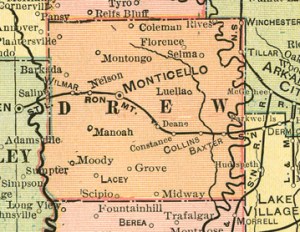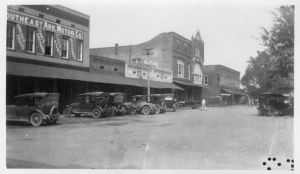 Monticello is the largest town in southeast Arkansas south of Pine Bluff (Jefferson County). Its history is one of continued growth and prosperity. Located at the intersection of two major roads and served early by railroads, it became an enduring commercial hub. A diversified infrastructure consisting of commerce, agriculture, and the timber industry created a strong foundation and sustained the town's growth. The town also became an important educational and medical center.
Monticello is the largest town in southeast Arkansas south of Pine Bluff (Jefferson County). Its history is one of continued growth and prosperity. Located at the intersection of two major roads and served early by railroads, it became an enduring commercial hub. A diversified infrastructure consisting of commerce, agriculture, and the timber industry created a strong foundation and sustained the town's growth. The town also became an important educational and medical center.
The first center of business and county court were at nearby Rough and Ready Hill, which was settled by 1836. Soon after Drew County formed in 1846, leading citizens decided that a new town should be built for the county seat. In 1849, Fountain C. and Polly Austin, early settlers, donated eighty-three acres for the town site. It is popularly believed that the citizens named the town after Thomas Jefferson's Virginia estate.
The first courthouse was constructed in 1851 on the court square in the center of town. A second building replaced it in 1857.
Lots were donated in the early 1850s for building Baptist, Methodist, and Presbyterian churches. Lots were also set aside for a male academy, a female academy, and a cemetery. A library was established in the courthouse in 1857. The earliest newspaper, the Sage of Monticello, began publishing in 1857. Among the pre–Civil War establishments were G. W. Simms & Co. General Merchandise, I. A. Price Dry Goods, M. A. Wilson & Co., Charles Millerd & Alexander Hale Contractors, Henry Lephiew Grocery & Liquor, M. H. Burks & Bro. Hardware, Lephiew & Duval Grocery & Liquor, and Dr. H. F. Bailey Drug Store.
Commercial progress continued until the Civil War. The town witnessed three minor skirmishes in 1864 (January 13–14, March 18, and September 9–11) and three in 1865 (January 26–31, March 21–23, and May 23–27). They all concerned Union forces raiding for supplies and artillery and looking for Confederate soldiers. On one occasion, they entered Colonel William F. Slemons's house to search for him, but he eluded them by hiding in a hotel loft. Rodger's Female Academy, established in 1857, was used as a Confederate hospital. The Confederates used Phi Kappa Sigma Male College as a storehouse for supplies. Union forces burned the building in 1865, though the Union occupied the town. The last skirmish to occur in Monticello happened after the formal surrender of the Confederacy. Word had not yet arrived that the war had ended.

The Reconstruction period witnessed the organization of the Ku Klux Klan in the county in retaliation against "carpetbagger" rule. Officials and citizens reached an agreement that whites would continue serving as county officials and African Americans would be elected representatives. Two prominent black citizens, Curl Trotter and Lynn L. Brooks, are given credit for helping ease the tension by using their influence with members of their race.
A newspaper, the Monticellonian, was established in 1870; it was followed by the Drew County Advance in 1892. The long-awaited Little Rock, Mississippi River, and Texas Railroad (later known as the Iron Mountain) reached the town in 1880 and provided faster and better long-distance transportation. From 1874 to 1896, Monticello hosted the Southeast Arkansas Fair. People attended from all over southeast Arkansas and northeast Louisiana. The town's most enduring mercantile store opened in 1881 when John J. McCloy and Virgil J. Trotter Sr. formed McCloy & Trotter Mercantile and Grocery. After McCloy's death, the business continued as V. J. Trotter & Sons until it was sold in 1970. The first bank, Monticello Bank, opened in April 1887. Also in 1887, Hannah Hyatt began accepting orphans into her home. She donated her home and eighty acres to the State Baptist Convention in 1894, and the institution became the Arkansas Baptist Home for Children, which still exists. Telephone service reached the town in 1898. A cottonseed oil mill opened in 1890.
Monticello experienced immense growth in the early twentieth century. The Monticello Cotton Mill, founded by Warren Anderson, opened in 1900. Two cotton gins, a fertilizer plant, an ice plant, and a canning factory were built in connection with the cottonseed mill during this era. Several new banks formed. Mrs. James Gaston Williamson (née Lula Jackson) organized United Charities, composed of ladies from the town churches, in 1910. United Charities established a nursery for children whose mothers worked at the cotton mill and a home for women who were no longer able to work there. This effort led to the creation of the Vera Lloyd Presbyterian Home for Children in 1924; it still exists. Martin L. Sigman established a stave mill in 1914. The Sorosis Club, formed in 1902, established the Drew County Library in 1928. The next decade saw more progress. The Mack Wilson Hospital opened in 1930. The same year, Edward Lee Stephenson founded Stephenson's Funeral Home, now the Stephenson-Dearman Funeral Home. A new courthouse was erected in 1932, and a municipal building was built two years later. A Coca-Cola plant opened in 1935, and a municipal swimming pool opened the next year.
 Soon after the outbreak of World War II, the effects of the Depression began to diminish. The Monticello Cotton Mill manufactured a coarse grade of cotton material that was used by the military for tents, cots, and awnings. It ran at full capacity throughout the war and employed many, enticing more rural people to relocate.
Soon after the outbreak of World War II, the effects of the Depression began to diminish. The Monticello Cotton Mill manufactured a coarse grade of cotton material that was used by the military for tents, cots, and awnings. It ran at full capacity throughout the war and employed many, enticing more rural people to relocate.
Drew Memorial Hospital was built in 1950, and in 1975, a modern building replaced the original. Local resident John Porter Price established the J. P. Price Lumber Company in 1965; it claims to be one of the largest wood-processing companies in the United States. Among the major industries in 1974 were Arvin (automotive exhaust systems manufacturer), L. T. Barnes (pulpwood), Burlington Industries (textiles), the Coca-Cola Bottling Company, Davis Forest Services, Drew Cotton Seed Oil Mill (later Drew Foam), Dura-Craft Boats (now War Eagle Boats), Georgia-Pacific (forestry), MonArk Boat Company , and Wilson Sawmill. Richard Akin established Akin Industries, manufacturing furniture for healthcare customers, in 1985. The building of a Walmart Supercenter in the 1990s spurred commercial development west of the center of town. Chuck and David Dearman of Dearman Companies established North Park Village Shopping Center next to Walmart Inc.
